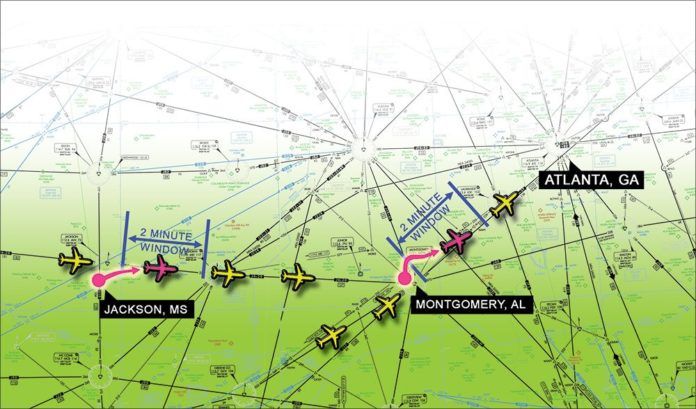Imagine a Piper J3 Cub parked beside a mighty double-decker Airbus A380. The two airplanes couldn’t be more different, yet both function on the same four principles: thrust, drag, lift, and weight. The 1.2 million pound Airbus just scales them up a thousand times over the 1,200 pound Piper.
Each aircraft is designed for its purpose. The A380 is perfect for carrying you and 600 friends around the world, but unlike the Cub it wouldn’t do well on a short, rough grass strip.
Air Traffic Control facilities are also designed to their mission. ATC’s control tower, the J3 of the system, manages traffic within a few miles. Managing the flow around the larger airports are Terminal Radar “Approach” Control facilities. Above the TRACONs lie Air Route Traffic Control Centers with hundreds of controllers watching thousands of cubic miles of sky. Each facility has the same purpose—order and safety—on increasingly larger scales.
As large as Centers are, the “A380” is the Air Traffic Control System Command Center in Warrenton, Virginia. It is responsible for the entire National Airspace System. Unlike tower or radar controllers who micromanage up to 30 planes at a time, the ATCSCC oversees the five thousand or so aircraft at any given moment over the United States.
Pilots never talk to it. It has no frequencies or sectors. Like a conductor keeping time for a large orchestra, it plays no instrument, but instead keeps every note and musician working in unison. On a national scale, it enforces the same order and safety as your local tower through the use of information, coordination, and restrictions.
Everyone Plays
Task saturation plagues all aspects of aviation. The more complex a situation, the easier it is to fall behind in the cockpit or at the radar scope, and the more order and safety may be compromised.
The Command Center’s job is to ensure a balanced flow of traffic, preventing any part of the system from getting overwhelmed by too many aircraft. Predicting and handling an overload demands accurate data and teamwork.
The Collaborative Decision Making organization, a joint effort by the ATCSCC, its subordinate ATC facilities, over two dozen airlines, and academic personnel, is tasked with balancing the traffic flow throughout the US.
The ATCSCC talks with all CDM members every two hours. The decision making starts with facts. Every airport has a limit to how many arrivals it can handle, known as the Airport Arrival Rate. The ARR is typically 60 airplanes per runway per hour. Also, by agreement with the CDM, the airlines share with the ATCSCC their proposed flight schedule. By tallying up all the flights into a particular airport, they determine how much traffic that airport—and any ATC facility responsible for it—will be facing.
The result is an operational plan for the day that accounts for those known facts as well as forecast problems, such as runway closures, equipment outages, and, of course, weather issues. Everything in this system is interconnected. What affects one airport will affect all of the Centers and TRACONs who feed it. It’s a ripple effect on a national scale.
This collaborative system is designed to adapt and handle the unpredictable, random events that can interrupt the national flow of traffic.
Seizing the Initiative
Major Class B airports—such as New York’s La Guardia and JFK, Atlanta’s Hartsfield, and Charlotte’s Douglas—face solid streams of moving metal inbound from all directions. That’s thousands of aircraft per day, per airport. Even when the weather’s clear and equipment’s working normally, that amount of volume needs to be tightly managed.
If the Command Center determines that due to over scheduling or deteriorating weather the number of arrivals and departures scheduled for a given airport exceeds the field’s actual capacity, then it’s TMI time. Not “Too Much Information,” but “Traffic Management Initiative,” a solution to handle the excess traffic.
TMIs can start out small. Let’s say a low overcast blankets Chicago O’Hare.
Now relying on instrument instead of visual approaches, it must slow the arrival rate. The Approach controllers are already vectoring their butts off, but are facing a huge influx expected between 1500Z and 1600Z. The inbound aircraft are spaced only five or ten miles from one another.
Chicago Approach can coordinate a TMI with the ATCSCC and Chicago Centre, requiring that Center feed the airplanes to Approach spaced by thirty miles. The Center controllers have to work a bit harder, but it offers breathing room to the Approach guys sequencing planes to final.
Sometimes, though, a bigger problem needs a bigger hammer. If demand is forecast to exceed capacity for several hours, a more drastic TMI is needed.
Park ‘Em
Via CDM conference calls, the ATCSCC can propose a new solution—a Ground Delay Program (GDP)—and include it in their operational plan. However, it won’t actually put it into effect until it’s been coordinated with the affected airlines and ATC facilities. This is a team effort that affects hundreds of flights and tens of thousands of passengers, so the Command Center wants to make sure all parties have their say.
Once a revised, reduced Airport Arrival Rate is agreed upon, it’s number crunching time. The original proposed arrival time for every flight scheduled to O’Hare is run through a series of programmed algorithms. Every flight is then given an EDCT: an Expect Departure Clearance Time. The plane cannot takeoff until it’s within five minutes before or after that time, as described in AIM 5-2
6. This thins out the arrival stream into Chicago to match the new AAR.
The ATCSCC’s software assigns those EDCTs on an equitable basis. Chicago, in this case, is one of United Airlines’ major hubs. Therefore, UAL gets assigned a higher than average amount of the arrival slots per hour.
Airlines can also be flexible within the slots they’re given. Before the GDP, a UAL 737 was scheduled to depart at 1205Z from Boston. Fifty of its passengers have international connections, but it gets slapped with an EDCT of 1345Z. In the meantime, a UAL Embraer 170 with only five connecting passengers gets a time of 1245Z. United can swap the times and allow the 737 to go first. The regional jet’s passengers won’t be too happy, but the airline’s philosophy is that scheduling damage can’t be eliminated, but it can be reduced.
EDCTs apply to general aviation too, not just air carriers. If you’re departing from a towered airport to any airport facing a GDP, the Clearance Delivery controller should advise you if you’ve been affected. If you’re departing an uncontrolled field for a major airport, you can check if you’re subject to an
EDCT via the ATC Command Center’s EDCT web site: http://www.fly.faa.gov/edct.
Still No Room
What if, despite Call For Release (CFR) and EDCTs, a particular Center or TRACON still has planes stacked in holding patterns, waiting to land? The ATCSCC can chop the throttle to idle and shut down traffic flow at the source.
Enter the ground stop, the ultimate GDP. Airplanes intended for the beleaguered airport are now forbidden to takeoff, giving controllers a fighting chance to organize their traffic. It’s a drastic measure that can disrupt airline and passenger schedules badly, in trade for more of that ol’ order and safety.
These ground stops are the measure of last resort, often instituted when a critical situation occurs, such as an accident, unusually bad weather, or ATC equipment failure. While the ATCSCC is the focal point for all traffic management decisions, ground stops often originate at lower level facilities.
Last year, I saw an entire Center ground stop all traffic in its jurisdiction because of a major weather system covering up half the state. Even towers can demand ground stops to handle emergency situations.
Fort Lauderdale-Hollywood International Airport (KFLL) has only two operational runways—9L and 13—and they intersect. What if an airliner suffers a nose gear collapse and grinds to a halt where both runways meet, shutting down the entire airport in one sparking, nerve wracking moment? The damage is done. Now it’s time to act quickly and effectively to avoid a catastrophe.
The tower calls Miami Approach and tells them to hold all incoming traffic in the immediate area. Both ATC facilities then conference call with Miami Center, possibly neighboring Jacksonville Center, the CDM, and the ATCSCC to organize a proper national ground stop. Until everything gets sorted out on the ground at KFLL, the hundreds of inbound planes and planned departures must be held on the ground or taken to alternate airports. Affected parties will be kept updated via situation reports and the game plan will be adapted as needed.
With this situation, and all others faced by the ATCSCC, the focus is on accurate information and timely coordination. The restrictions that result may seem inconvenient, but without them, the National Airspace System could descend into chaos. Through sound leadership, teamwork, and rapid response times, the Air Traffic Control System Command Center ensures order—therefore enhancing safety—for the thousands of pilots, passengers, and controllers beneath its oversight.
Call For Release Program
Jet routes and victor airways are no different than automotive highways in that too many planes on the same stretch of “road” inevitably cause traffic jams. The ATCSCC authorizes Centers and some large TRACONs to institute Call for Release (CFR) programs to manage traffic flow. Unlike EDCTs, the CFR is not based on arrival times. Instead, this program merges departing aircraft into the overhead stream of traffic to major airports.
Since aircraft can’t exactly check their rearview mirrors to see all the traffic and find a gap, it falls on ATC to find (or make) the gaps in the flow. Tower controllers are therefore forbidden from launching departures to certain destinations without—you guessed it—calling for a release.
Some busy towers will ask the pilot for an estimated wheels up time when the pilot calls for the clearance. That time needs to be realistic and should account for loading, pushback, taxi times and anything else the pilot can foresee before being ready for takeoff. Other towers might ask the pilot to let them know five minutes prior to engine start. The largest airports with huge lines of airplanes may not even bother the pilot. They’ll call for the release when they can reasonably estimate that the airplane is 15 minutes from takeoff.
Once the departure time is known, the Clearance or Ground controller calls the overlying Center’s Traffic Management Coordinator (TMC) for a release window. These TMC middlemen coordinate and manage traffic flow programs with their own controllers, neighboring ATC facilities, and towers in their jurisdiction.
With a call for release, the TMC enters the expected departure time. The system then examines other traffic en route to the destination and finds a gap in the flow and automatically generates a release window allowing the departure to slide right in to that gap. With major hubs such as Atlanta, the release window may be just two minutes. Hitting that window demands teamwork. The aircraft needs to be ready. Ground needs to taxi the plane to the runway in time and Tower needs to build a gap in local traffic for the timed departure.
If the window is missed, the process repeats, but this time often with unpleasant results. I’ve seen airliners delayed for 45 minutes or more because they were a couple minutes late for their window. There’s nothing the tower can do for them—or their unfortunate passengers—except find them a comfortable place to park. The rules simply don’t permit a tower to launch a plane outside of the CFR window.
The moral of this story is to be realistic, even conservative, if you’re ever asked when you can be ready. It’s better to be ready and wait a few minutes than miss the window and have to wait an hour for the next one. —TK
Tarrance Kramer is an Air Traffic Controller in the southeast US and is a contributing editor to IFR.





